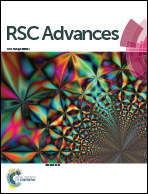A two-photon lysosome-targeted probe for endogenous formaldehyde in living cells†
Abstract
Formaldehyde (FA) is a gaseous signaling molecule that plays a vital role in various biological processes as well as neurodegenerative diseases. Therefore, it is of great practical significance to develop effective and reliable chemical sensors for the monitoring of endogenous FA. Here, we designed and synthesized a two-photon (810 nm) turn-on chemosensor AMNT (aminomorpholine naphthalimide) that accurately localizes lysosomes in cells for imaging of cellular endogenous FA. The fluorescence emission peak of AMNT was at ∼540 nm, with a slight blue shift (∼528 nm) in response to FA, while the green fluorescence intensity increased. The probe exhibits excellent selectivity for FA among other biological interference species and a fast response time for FA. It is worth mentioning that the probe successfully imaged endogenous FA in cells in two-photon mode, making the probe an effective research tool in the biomedical field to study diseases related to abnormal FA expression.



 Please wait while we load your content...
Please wait while we load your content...